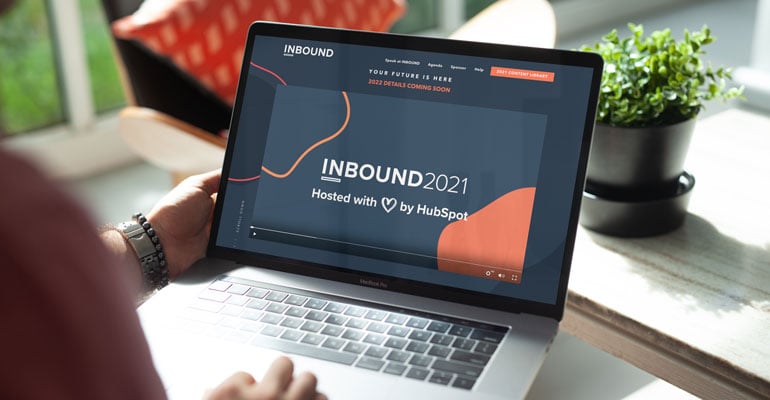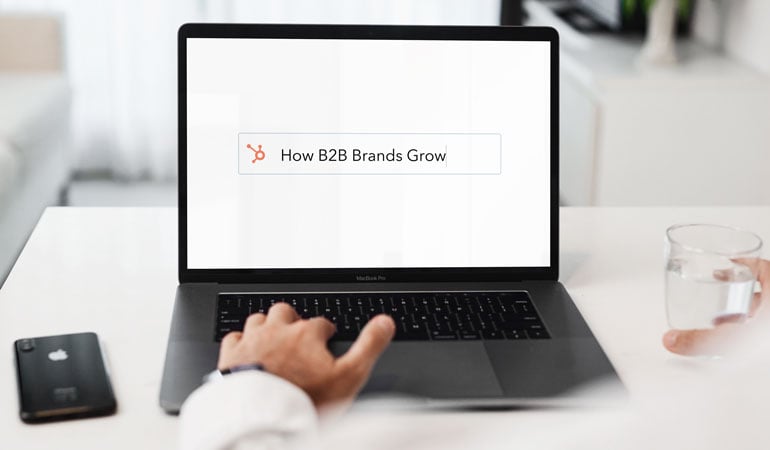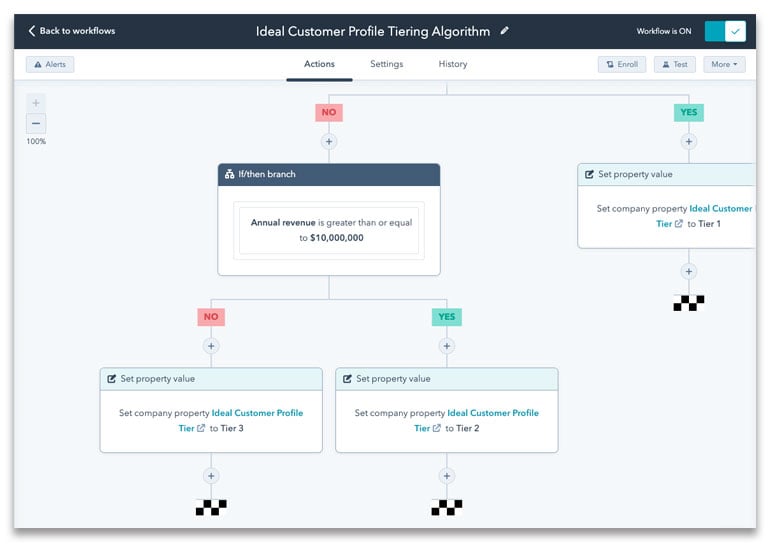The Innovation Visual team recently attended HubSpot’s Inbound 2021, one of the worlds’ largest global inbound marketing events. The event spanned three days and encompassed a wide range of inspiring discussions across all areas of digital marketing and culture. This year also saw some particularly inspiring speakers, including the likes of Oprah Winfrey and Spike Lee.

While the event was used to present and announce a series of new HubSpot tools and updates, its primary goal was to share ideas from industry leaders, many of whom delivered some exceptional sessions on the current inbound marketing thought-leadership and emerging trends. As a team we value Inbound as it is a great way to ensure we stay up to date on all things new in this area of digital marketing. Here are a few ideas from two presentations that stood out for us in particular this year:
How B2B Brands Grow: Great Marketing Drives Sustainable Growth for Companies, by Ty Heath & Jon Lombardo, LinkedIn
According to Heath and Lombardo, “mind share drives market share”. By mind share they mean the brand that is front of mind for a buyer when they start their buyers’ journey, their term for that positioning is metal availability. They state that the key issue that many B2B brands face when trying to facilitate growth is that they do not have sufficient ‘mental availability’. Mental availability is defined, by Professor Jenni Romaniuk, as increasing the probability of your brand coming to your customers mind in different buying situations. This session covered why increasing mental availability should be the B2B marketers single most important objective and how to achieve it. Here is a summary of some of the key marketing rules they shared when working to increase the mental availability of a brand:

95-5 Rule
Heath and Lombardo suggested that up to 95% of B2B buyers are not in the market for many goods and services at any one time over a quarter. That suggests that just 20% of business buyers are in the market over the course of an entire year and so most advertising is directed at B2B buyers that aren’t going to buy any time soon. Therefore, using the 95-5 rule, a business should focus on priming future buyers (the 95% that aren’t in the market now) with their brand to build mental availability, so that their brand is what buyers are familiar with when they move into market. Building that familiarity is essential because most B2B buyers buy what is mentally available, with little evaluation. This approach helps B2B marketers manage growth over time by working to build brand awareness in potential customers before they even enter their buyer’s journey.
Brand Rejection
Many businesses fear brand rejection, with 71% of B2B marketers focusing on brand perception, rather than brand awareness. However, the real issue in the B2B market is brand unawareness, most people just don’t think about the vast proportion of B2B brands at all. The data they shared demonstrated that instances of brand rejection are rare and that customers who have not used a brand rarely actively reject it and the same occurs for those who have used a brand in the past. Typically, rejection is based on experience. Ty and Jon suggest that the key focus for businesses should be on building awareness that links them to a customer’s key buying situation, so that their brand is what a customer thinks of when a need needs to be fulfilled, because that mental affiliation can help overcome buying objections and often means buyers bypass competitors in the selection process entirely.
The Duplicate Purchase Law
Another common misconception that B2B marketers make is that brand perception and positioning determines their competition, when in reality, brand penetration is key. The Duplicate Purchase Law states that a business’s main competitors are typically the biggest brands in the category, irrespective of image or positioning and that marketers cannot choose who they compete with. Customers are more likely to choose to purchase from the larger brands because those brands have greater mental and physical availability. Not only do B2B brands compete with the largest brands in their market for new customers, but also share their customers with those larger penetration competitors. Therefore, it is essential for smaller B2B businesses to focus on building strong relationships and branding across all marketing activities to overcome the attention bias towards larger competitors.
Conclusions on B2B Growth
As highlighted throughout the session, the key to growing a B2B brand is by focusing on building the mental availability of the brand so that when a consumer moves into market, they are already aware of your brand. We found this tip especially useful in building a strategy to grow mental availability within a business:
Remember RMB
- Reach – Ensure you reach everyone in the category.
- Message – Message around category entry points to link your brand to key buying situations.
- Brand – Use distinctive brand assets across all marketing efforts.
The 7 Fundamentals of a Strong ABM Strategy, by Tiphaine Amblard
The B2B world is evolving, with an increasing number of businesses entering the market, making it essential for a brand to differentiate itself from the competition to facilitate growth and delight customers and prospects. Amblard discussed how implementing a strong Account Based Marketing (ABM) strategy can strengthen business relationships and increase revenue.
The Difference between Inbound Marketing and ABM
Key to Amblard’s presentation was clarifying the difference between inbound marketing and account based marketing. She asserted that inbound marketing is a methodology that attracts customers by creating valuable content and experiences to meet the customer’s needs, through techniques such as marketing automation and content marketing. Whereas ABM is a growth strategy which focuses on building experiences for a set of mutually identified high-value accounts.
A key difference between the two practices is that inbound marketing focuses on creating helpful content for buyer personas within a specific market, whereas ABM targets key accounts within the market. Another key difference is that the main objective of Inbound marketing is to target new customers, whereas an ABM strategy focuses on upselling to current customers as well as to new clients.
She explained that, despite the various differences between Inbound marketing and ABM, the two marketing strategies often work well when used strategically and in conjunction, starting with an Inbound strategy to gain new customers, followed by an ABM strategy to upsell to key accounts. You can find out more about Inbound methodology, or read on to discover the key steps to implementing a strong ABM strategy.

Screenshot courtesy of Hubspot
The 7 Key Steps to Implementing an ABM Strategy
Step 1: Planning
The key to planning an ABM strategy is to focus on your taskforce. This involves raising awareness and coordinating all marketing and sales teams to ensure collaboration towards the same goal. Within the planning stage, it is also essential to define your budget, resources, objectives and KPIs.
Step 2: Identify Target Accounts
The next step involves identifying the key accounts based on the different sets of data from your sales and marketing teams. There are various data sets which can be used to identify your target accounts including:
- Website visits
- Current deals
- Historical deals
- Ideal customer profile (ICP)
For example, HubSpot Insights will allow us to segment accounts based on region, industry, number of employees and revenue. Tools like Bombora will then allow us to better understand which of these accounts are currently in the marketing for our products and services meaning we can then focus our ABM campaigns on engaged accounts who fall into our ICP definitions.
Step 3: Identify Key Accounts
Once your target accounts have been chosen, you should name and number them and choose where the account fits within the various levels of ABM campaign:
- One-to-One campaign – Executing highly customised programs for individual accounts
- One-to-Few campaign – Executing lightly-customised programs for groups of accounts with similar issues and needs
- One-to-Many campaign – Leveraging technology to tailor and personalise marketing campaigns for specific, named accounts at scale
At this stage, it is essential to have a clear ICP and understand the attributes of the business, including size, location, budget etc. Once this has been defined, you should build your understanding of the challenges of the market that your ICP operates in to allow you to provide the solution to these challenges.
Step 4: Account Mapping
Account mapping involves determining the key decision-making functions of your strategic accounts, creating the personas of the key contacts and building a decision circle. This will ensure that all the stakeholders of the decision-making process are considered when producing your content.
Account mapping involves determining the key decision-makers of your target accounts, creating personas of the key contacts, and identifying the full Decision-Making Unit (DMU). This will ensure that all the stakeholders of the decision-making process are considered when producing your content.
Step 5: Customise Your Content Strategy
To produce a tailored content strategy, you should analyse your previous marketing actions with the target accounts to see which marketing efforts they have interacted with in the past. This will allow you to build your editorial strategy by understanding any issues with your previous marketing efforts and providing a solution for these.
Step 6: Launch Your ABM Campaign
When launching your ABM campaign, you need to coordinate your approach across all three dimensions – target contacts, content and channels. Ensuring that the each element is used in the right way, at the right time, for the right audience type, in the same way you would any targeted marketing campaign.
Step 7: Track, Measure and Analyse Your ABM Campaign
After the campaign is live, you should analyse the campaign in terms of qualitative and quantitative KPIs:
Qualitative:
- Reach – Are you reaching your target accounts? When are people dropping?
- Influence – Which media channels generate the most results?
Quantitative:
- Number of engagements or conversions from your different target accounts
- Number of contracts signed
- New revenue generated
Summary
We thoroughly enjoyed the inspiring talks from the incredible speakers at INBOUND and found their new approaches to fresh ideas as well as more established concepts refreshing and energising. This blog only touches on the breadth of content and concepts that Inbound offered and the team will be extracting full value from all of the relevant presentations over the next few weeks.
Get in Touch
As digital marketing experts, we are passionate about delivering results for a range of businesses through a variety of digital marketing methods and we know that by staying up to date we can offer better, more effective services to our clients. If you are looking to implement a successful Inbound campaign to generate loyal customers, then we can help. Why not get in touch today or call us on 0333 772 0509 to find out more?







